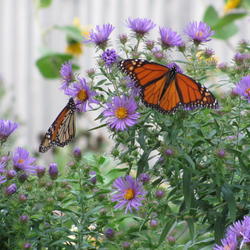
The colors of autumn are upon us. While we should sit back and enjoy the show, this is also the time of year to prepare to grow more color for next year. Fall is the perfect time to plant wildflowers in most of the country. Cool, wet days allow the seed of perennial flowers to germinate, while annual flower seed can lie dormant until spring.
Whether you're starting a new wildflower patch or renovating an old one, now is the time.
Selecting WildflowersThe first step in growing a new wildflower patch is to select the right varieties for your region. Many companies offer general North American mixes and specific regional mixes, such as the Texas blend. Regional mixes feature annual, biennial, and perennial flowers that are known to grow well in a particular area. Some seeds come woven in pre-sown wildflower mats that you just roll out and water. This is the easiest way to get started.
Another approach is to pick out your favorite individual wildflowers and create your own mix. Here are some widely adapted wildflowers to try.
Indian Blanket -This annual produces red, daisy-like flowers with yellow edging. It blooms in early summer.
Black Eyed Susan - This classic, perennial wildflower features bright yellow flower petals with a black center. It flowers from midsummer until fall.
Shirley Poppy - This annual produces papery flowers in shades of pink, red, and white. It flowers from spring until mid-summer and often self sows.
Purple Coneflower - This native American perennial produces purple-petaled flowers with a prickly orange center (cone). It flowers from midsummer until frost. It naturalizes and spreads easily.
Lupine - This perennial produces tall flower spikes that bloom in early summer in colors such as red, blue, pink, and white. They naturalize easily.
Seeding a Wildflower MeadowMost wildflowers grow best in full sun, so select an area that gets at least 6 hours of direct sun a day. You can plant wildflowers almost anywhere: along a driveway, in a meadow, in a garden, along a road, or on banks. Mow the wildflower area close to the ground. If it's an abandoned field, brush hog the area first before mowing more closely with a lawn mower, if possible. Try to avoid tilling the wildflower area deeply, which brings dormant weed seeds to the soil surface to germinate and compete with your wildflowers for water and nutrients in spring. Instead, kill the existing vegetation by hand pulling tough perennial weeds and using a flame weeder or organic herbicide to kill all the other weeds. Using a flamer and herbicide helps create spaces for wildflower seeds to get started.
After treating the vegetation, shallowly scratch or lightly till the soil surface and sow your wildflower seeds. Scatter them over the area as evenly as possible, first walking in one direction and then in the perpendicular direction. Press the seed into the soil with your footsteps.
Maintaining Your WildflowersKeep the wildflower patch well watered this fall if the weather is dry. In spring the patch should start growing. It's inevitable that some weeds will appear in your new planting. At first, it will be difficult to distinguish them from the wildflowers, but pull any grasses and be highly suspicious of any plant that's growing much faster than everything else. By spring the first flowers will appear. During the first year, many wildflower patches are dominated by annuals such baby's breath, sunflowers, and cosmos. These showy colors will give way to perennials such as Black Eyed Susans and Coneflowers in subsequent years.
Fall Wildflower CareLet your wildflowers thrive all summer. Come fall, as the blossoms fade, mow the patch and leave the cuttings on the ground. Many annual flowers will drop their seeds and self-sow to return for a second show next spring.
By maintaining the wildflower patch each year, you can often go 3 to 4 years before weeds and grasses eventually take over your patch. Then it's time to start all over again with another beautiful wildflower meadow.
 Charlie Nardozzi is an award winning, nationally recognized garden writer, speaker, radio, and television personality. He has worked for more than 30 years bringing expert gardening information to home gardeners through radio, television, talks, tours, on-line, and the printed page. Charlie delights in making gardening information simple, easy, fun and accessible to everyone. He's the author of 6 books, has three radio shows in New England and a TV show. He leads Garden Tours around the world and consults with organizations and companies about gardening programs. See more about him at Gardening With Charlie.
Charlie Nardozzi is an award winning, nationally recognized garden writer, speaker, radio, and television personality. He has worked for more than 30 years bringing expert gardening information to home gardeners through radio, television, talks, tours, on-line, and the printed page. Charlie delights in making gardening information simple, easy, fun and accessible to everyone. He's the author of 6 books, has three radio shows in New England and a TV show. He leads Garden Tours around the world and consults with organizations and companies about gardening programs. See more about him at Gardening With Charlie.